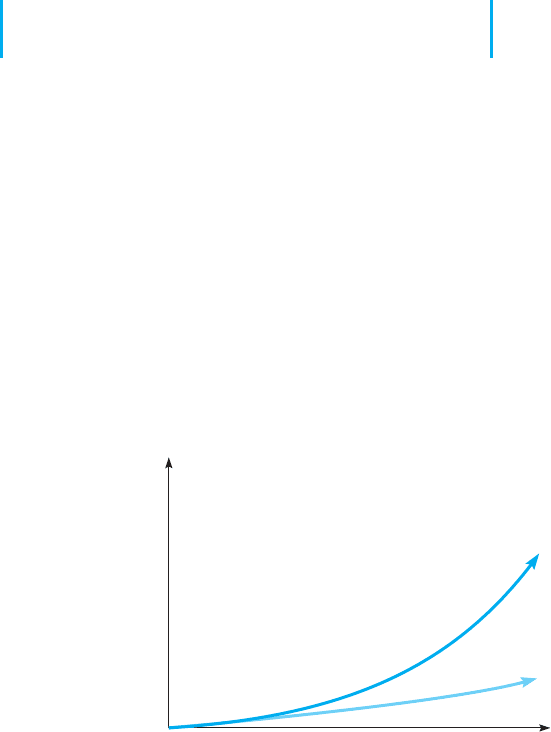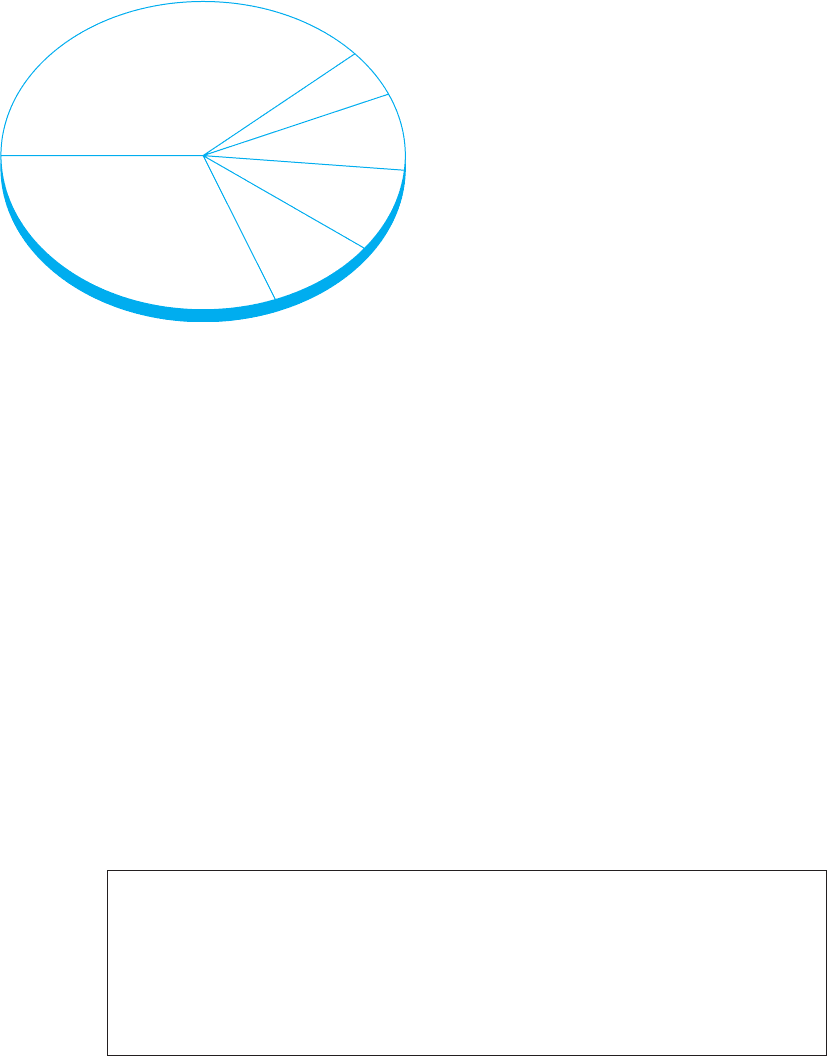FitzGerald J., Dennis A., Durcikova A. Business Data Communications and Networking
Подождите немного. Документ загружается.


12.4 PERFORMANCE AND FAULT MANAGEMENT 465
12.4.4 Improving Performance
The chapters on LANs, BNs, and WANs discussed several specific actions that could be
taken to improve network performance for each of those types of networks. There are
also several general activities to improve performance that cut across the different types
of networks.
Policy-Based Management A new approach to managing performance is
policy-based management. With policy-based management, the network manager uses
special software to set priority policies for network traffic that take effect when the
network becomes busy. For example, the network manager might say that order
processing and videoconferencing get the highest priority (order processing because it
is the lifeblood of the company and videoconferencing because poor response time will
have the greatest impact on it). The policy management software would then configure
the network devices using the QoS capabilities in TCP/IP and/or ATM to give these
applications the highest priority when the devices become busy.
Service-Level Agreements More organizations establish service-level agreements
(SLAs) with their common carriers and Internet service providers. An SLA specifies
the exact type of performance and fault conditions that the organization will accept. For
example, the SLA might state that network availability must be 99 percent or higher and
that the MTBF for T1 circuits must be 120 days or more. In many cases, SLA includes
maximum allowable response times. The SLA also states what compensation the service
provider must provide if it fails to meet the SLA. Some organizations are also starting
12.4 INSIDE A SERVICE-LEVEL AGREEMENT
TECHNICAL
FOCUS
There are many elements to a solid service-level
agreement (SLA) with a common carrier. Some of
the important ones include
•
Network availability, measured over a month as
the percentage of time the network is available
(e.g., [total hours—hours unavailable]/total hours)
should be at least 99.5 percent
•
Average round-trip permanent virtual circuit
(PVC) delay, measured over a month as the num-
ber of seconds it takes a message to travel over
the PVC from sender to receiver, should be less
than 110 milliseconds, although some carriers will
offer discounted services for SLA guarantees of
300 milliseconds or less
•
PVC throughput, measured over a month as the
number of outbound packets sent over a PVC
divided by the inbound packets received at the
destination (not counting packets over the com-
mitted information rate, which are discard eligi-
ble), should be above 99 percent—ideally, 99.99
percent
•
Mean time to respond, measured as a monthly
average of the time from inception of trouble
ticket until repair personnel are on site, should be
4 hours or less
•
Mean time to fix, measured as a monthly average
of the time from the arrival of repair personnel
on-site until the problem is repaired, should be
4 hours or less
SOURCE: ‘‘Carrier Service-Level Agreements,’’
International Engineering Consortium Tutorial,
www.iec.org, February 2001.

466 CHAPTER 12 NETWORK MANAGEMENT
to use an SLA internally to define relationships between the networking group and its
organizational “customers.”
12.5 END USER SUPPORT
Providing end user support means solving whatever problems users encounter while
using the network. There are three main functions within end user support: resolving
network faults, resolving user problems, and training. We have already discussed how to
resolve network faults, and now we focus on resolution of user problems and end user
training.
12.5.1 Resolving Problems
Problems with user equipment (as distinct from network equipment) usually stem from
three major sources. The first is a failed hardware device. These are usually the easiest
to fix. A network technician simply fixes the device or installs a new part.
The second type of problem is a lack of user knowledge. These problems can
usually be solved by discussing the situation with the user and taking that person through
the process step by step. This is the next easiest type of problem to solve and can often
be done by email or over the telephone, although not all users are easy to work with.
Problematic users are sometimes called ID ten-T errors, written ID10T.
The third type of problem is one with the software, software settings, or an incom-
patibility between the software and network software and hardware. In this case, there
may be a bug in the software or the software may not function properly on a certain
combination of hardware and software. Solving these problems may be difficult because
they require expertise with the specific software package in use and sometimes require
software upgrades from the vendor.
Resolving either type of software problem begins with a request for assistance from
the help desk. Requests for assistance are usually handled in the same manner as network
faults. A trouble log is maintained to document all incoming requests and the manner in
which they are resolved. The staff member receiving the request attempts to resolve the
problem in the best manner possible. Staff members should be provided with a set of
standard procedures or scripts for soliciting information from the user about problems.
In large organizations, this process may be supported by special software.
There are often several levels to the problem-resolution process. The first level is
the most basic. All staff members working at the help desk should be able to resolve
most of these. Most organizations strive to resolve between 75 and 85 percent of requests
at this first level in less than an hour. If the request cannot be resolved, it is escalated to
the second level of problem resolution. Escalation is a normal part of the process and not
something that is “bad.” Staff members who handle second-level support have specialized
skills in certain problem areas or with certain types of software and hardware. In most
cases, problems are resolved at this level. Some large organizations also have a third
level of resolution in which specialists spend many hours developing and testing various
solutions to the problem, often in conjunction with staff members from the vendors of
network software and hardware.

12.6 COST MANAGEMENT 467
12.5.2 Providing End User Training
End user training is an ongoing responsibility of the network manager. Training is a key
part in the implementation of new networks or network components. It is also important
to have an ongoing training program because employees may change job functions and
new employees require training to use the organization’s networks.
Training usually is conducted through in-class, one-on-one instruction, and online
self-paced courses. In-class training should focus on the 20 percent of the network func-
tions that the user will use 80 percent of the time instead of attempting to cover all
network functions. By getting in-depth instruction on the fundamentals, users become
confident about what they need to do. The training should also explain how to locate
additional information from online support, documentation, or the help desk.
12.6 COST MANAGEMENT
One of the most challenging areas of network management over the past few years has
been cost management. Data traffic has been growing much more rapidly than has the
network management budget, which has forced network managers to provide greater
network capacity at an ever lower cost per megabyte (Figure 12.5). In this section, we
examine the major sources of costs and discuss several ways to reduce them.
12.6.1 Sources of Costs
The cost of operating a network in a large organization can be very expensive. Figure 12.6
shows a recent cost analysis to operate the network for one year at Indiana University,
a large Big Ten research university serving 36,000 students and 4,000 faculty and staff.
This analysis includes the costs of operating the network infrastructure and standard
applications such as email and the Web, but does not include the costs of other appli-
cations such as course management software, registration, student services, accounting,
Amount
Network traffi
c
Network budge
t
Time
FIGURE 12.5 Network
traffic versus network
management budgets

468 CHAPTER 12 NETWORK MANAGEMENT
Network Operations $14,871,000
Account Administration 275,000
Authentication Services 257,000
Directory Services Infrastructure (incl DHCP, DNS) 746,000
E-mail and Messaging 1,434,000
Mainframe and Cluster Operations 633,000
Mass Data Storage 1,424,000
Policy Management 75,000
Printing 201,000
Security Administration 1,270,000
WAN Operations 7,410,000
Web Services 1,146,000
End User Support $6,544,000
Departmental Technology Support 553,000
Instructional Technology Support 856,000
Student Residence Halls Support 279,000
Student Technology Centers Support 1,288,000
Support Center (Help Desk) 2,741,000
Training and Education 827,000
Client Hardware $3,901,000
Classroom Technology Equipment and Supplies 844,000
Student Residence Halls Equipment and Supplies 601,000
Student Technology Centers Equipment and Supplies 2,456,000
Application Software $3,729,000
Software Site Licenses 2,540,000
Student Residence Halls Software 146,000
Student Technology Centers Software 1,043,000
Total $29,045,000
FIGURE 12.6 Annual networking costs at Indiana University
and so on. Indiana University has a federal IT governance structure, which means that
the different colleges and schools on campus also have budgets to hire staff and buy
equipment for their faculty and staff. The budget in this figure omits these amounts, so
the real costs are probably 50 percent higher than those shown. Nonetheless, this presents
a snapshot of the costs of running a large network.
The largest area of costs in network operations is the $7.4 million spent on WAN
circuits. Indiana University operates many high-speed networks (including Internet2) so
these costs are higher than might be expected. This figure also shows the large costs of
email, Web services, data storage, and security. The cost of end user support is the next
largest cost item. This includes training as well as answering users’ questions and fixing
their problems. The remaining costs are purchasing new and replacement hardware and
software. But, once again, remember that this does not include the hardware and software
purchased by individual colleges and schools for their faculty and staff which does not
come from the central IT budget.
12.6 COST MANAGEMENT 469
The total cost of ownership (TCO) is a measure of how much it costs per year
to keep one computer operating. TCO includes the actual direct cost of repair parts,
software upgrades, and support staff members to maintain the network, install software,
administer the network (e.g., create user IDs, back up user data), provide training and
technical support, and upgrade hardware and software. It also includes the indirect cost
of time “wasted” by the user when problems occur, when the network is down, or when
the user is attempting to learn new software.
Several studies over the past few years by Gartner Group, Inc, a leading industry
research firm, suggest that the TCO of a computer is astoundingly high. Most studies
suggest that the TCO for typical Windows computers on a network is about $7,000
per computer per year. In other words, it costs almost five times as much each year to
operate a computer than it does to purchase it in the first place. Other studies by firms
such as IBM and Information Week, an industry magazine, have produced TCO estimates
of between $5,000 and $10,000 per year, suggesting that the Gartner Group’s estimates
are reasonable.
Although TCO has been accepted by many organizations, other firms argue against
the practice of including indirect in the calculation. For example, using a technique that
includes indirect, the TCO of a coffee machine is more than $50,000 per year—not
counting the cost of the coffee or supplies. The assumption that getting coffee “wastes”
12 minutes per day times 5 days per week yields 1 hour per week, or about 50 hours
per year, of wasted time. If you assume the coffeepot serves 20 employees who have an
average cost of $50 per hour (not an unusually high number), you have a loss of $50,000
per year.
Some organizations, therefore, prefer to focus on costing methods that examine
only the direct costs of operating the computers, omitting softer indirect costs such as
“wasted” time. Such measures, often called network cost of ownership (NCO) or real
TCO, have found that NCO ranges between $1,500 and $3,500 per computer per year.
The typical network management group for a 100-user network would therefore have
an annual budget of about $150,000 to $350,000. The most expensive item is personnel
(network managers and technicians), which typically accounts for 50 to 70 percent of
total costs. The second most expensive cost item is WAN circuits, followed by hardware
upgrades and replacement parts.
Calculating TCO for univerisites can be difficult. Do we calculate TCO for the
number of computers or the number of users. Figure 12.6 shows an annual cost of $29
million. If we use the number of users, the TCO is about $725 ($29 million divided by
40,000 users). If we use the number of computers, TCO is $4,800 ($29 million divided
by about 6,000 computers owned by the university).
There is one very important message from this pattern of costs. Because the largest
cost item is personnel time, the primary focus of cost management lies in designing
networks and developing policies to reduce personnel time, not to reduce hardware cost.
Over the long term, it makes more sense to buy more expensive equipment if it can
reduce the cost of network management.
Figure 12.7 shows the average breakdown of personnel costs by function. The
largest time cost (where staff members spend most of their time) is systems management,
which includes configuration, fault, and performance management tasks that focus on the
network as a whole. The second largest item is end user support.

470 CHAPTER 12 NETWORK MANAGEMENT
End user support
Systems management
Other
Application software
Network devices
Client computers
31%
38%
5%
8%
9%
9%
FIGURE 12.7 Network
management personnel costs
Network managers usually find it difficult to manage their budgets because networks
grow so rapidly. They often find themselves having to defend ever-increasing requests
for more equipment and staff. To counter these escalating costs, many large organizations
have adopted charge-back policies for users of WANs and mainframe-based networks.
(A charge-back policy attempts to allocate the costs associated with the network to
specific users.) These users must “pay” for their network usage by transferring part of
their budget allocations to the network group. Such policies are seldom used in LANs,
making one more potential cultural difference between network management styles.
12.6.2 Reducing Costs
Given the huge amounts in TCO or even the substantial amounts spent in NCO, there
is considerable pressure on network managers to reduce costs. Figure 12.8 summarizes
five steps to reduce network costs.
The first and most important step is to develop standards for client computers,
servers, and network devices (i.e., switches, routers). These standards define one config-
uration (or a small set of configurations) that are permitted for all computers and devices.
Standardizing hardware and software makes it easier to diagnose and fix problems. Also,
there are fewer software packages for the network support staff members to learn. The
downside, of course, is that rigid adherence to standards reduces innovation.
Five Steps to Reduce Network Costs
• Develop standard hardware and software configurations for client computers and servers.
• Automate as much of the network management function as possible by deploying a solid
set of network management tools.
• Reduce the costs of installing new hardware and software by working with vendors.
• Centralize help desks.
• Move to thin-client architectures.
FIGURE 12.8 Reducing network costs

12.6 COST MANAGEMENT 471
12.6
TOTAL COST OF OWNERSHIP
IN
MINNESOTA
MANAGEMENT
FOCUS
Total Cost of Ownership (TCO) has come to the
classroom. As part of a national TCO initiative,
several school districts, including one in Min-
nesota, recently conducted a TCO analysis. The
school district was a system of eight schools
(one high school, one middle school, and six
elementary schools) serving 4,100 students in
kindergarten through grade 12. All schools are
connected via a frame relay WAN to the district
head office.
Costs were assessed in two major groups:
direct costs and indirect costs. The direct costs
included the costs of hardware (replacement client
computers, servers, networks, and printers and
supplies), software, internal network staff, and
external consultants. The indirect costs included
staff training and development. ‘‘Wasted time’’
was not included in the TCO analysis.
The district examined its most recent annual
budget and allocated its spending into these
categories. The district calculated that it spent
about $1.2 million per year to support its 1,200
client computers, providing a TCO of about $1,004
per client computer per year. Figure 12.9 provides
a summary of the costs by category.
A TCO of $1,004 is below average, indicat-
ing a well-managed network. The district had
implemented several network management best
practices, such as using a standardized set of
software, using new standardized hardware, and
providing professional development to teachers
to reduce support costs. One other major con-
tributing factor was the extremely low salaries
paid to the IT technical staff (less than $25,000 per
year) because of the district’s rural location. Had
the district been located in a more urban area, IT
staff costs would double, bringing TCO closer to
the lower end of the national average.
SOURCE: ‘‘Minnesota District Case Study,’’ Taking
TCO to the Classroom, k12tco.gartner.com, 2004.
IT Staff
($451, 36%)
Consultants
($33, 3%)
Replacement
Hardware
($247, 25%)
Client
Computers
($201, 20%)
Servers
($29, 3%)
Network
($6, 1%)
Supplies
(
$11, 1%
)
Indirect Costs
($221, 18%)
Software
($52, 4%)
FIGURE 12.9 Total Cost of Ownership (per client computer per year) for a Minnesota
school district

472 CHAPTER 12 NETWORK MANAGEMENT
The second most important step is automate as much of the network management
process as possible. Desktop management can significantly reduce the cost to upgrade
when new software is released. It also enables faster installation of new computers
and faster recovery when software needs to be reinstalled and helps enforce the stan-
dards policies. Dynamic address assignment (e.g., DHCP; see Chapter 5) can reduce
time spent on managing TCP/IP addresses. The use of network management software
to identify and diagnose problems can significantly reduce time spent in performance
and fault management. Likewise, help desk software can cut the cost of the end support
function.
A third step is to do everything possible to reduce the time spent installing new
hardware and software. The cost of a network technician’s spending half a day to install
and configure new computers is often $300 to $500. Desktop management is an important
step to reducing costs, but careful purchasing can also go a long way. The installa-
tion of standard hardware and software (e.g., Microsoft Office) by the hardware vendor
can significantly reduce costs. Likewise, careful monitoring of hardware failures can
quickly identify vendors of less reliable equipment who should be avoided in the next
purchasing cycle.
Traditionally, help desks have been decentralized into user departments. The result
is a proliferation of help desks and support staff members, many of whom tend to
be generalists rather than specialists in one area. Many organizations have found that
centralizing help desks enables them to reduce the number of generalists and provide
more specialists in key technology areas. This results in faster resolution of difficult
problems. Centralization also makes it easier to identify common problems occurring in
different parts of the organization and take actions to reduce them.
Finally, many network experts argue that moving to thin-client architectures, just
Web browsers on the client (see Chapter 2), can significantly reduce costs. Although this
can reduce the cost to buy software, the real saving lies in the support costs. Because they
are restricted to a narrow set of functions and generally do not need software installations,
thin-client architectures become much easier to manage. TCO and NCO drop by 20 to
40 percent. Most organizations anticipate using thin-client architectures selectively, in
areas where applications are well defined and can easily be restricted.
12.7 IMPLICATIONS FOR MANAGEMENT
Network management is one of the more challenging functions because it requires a good
understanding of networking technologies, an ability to work with end users and man-
agement, and an understanding of the key elements driving networking costs. Normally
no one notices it until something goes wrong.
As demand for network capacity increases, the costs associated with network man-
agement have typically increased in most organizations. Justifying these increased costs
to senior management can be challenging because senior management often do not see
greatly increasing amounts of network traffic—all they see are increasing costs. The
ability to explain the business value of networks in terms understandable to senior man-
agement is an important skill.

SUMMARY 473
As networks become larger and more complex, network management will increase
in complexity. New technologies for managing networks will be developed, as vendors
attempt to increase the intelligence of networks and their ability to “self-heal.” These
new technologies will provide significantly more reliable networks, but will also be more
expensive and will require new skills on the part of network designers, network man-
agers, and network technicians. Keeping a trained network staff will become increasingly
difficult because once staff acquire experience with the new management tools, they will
be lured away by other firms offering higher salaries—which, we suppose, is not a bad
thing if you’re one of the network staff.
SUMMARY
Integrating LANs, WANs, and the Internet Today, the critical issue is the integration of all
organizational networks. The keys to integrating LANs, WANs, and the Web into one overall
organization network are for WAN managers to recognize that LAN/Web managers can make
independent decisions and for LAN/Web managers t o realize that they need to work within orga-
nizational standards.
Integrating Voice and Data Communications Another major challenge is combining voice
communications with data and image communications. This separation of voice and data worked
well for years, but changing communication technologies are generating enormous pressures to
combine them. A key factor in voice/data integration might turn out to be the elimination of one
key management position and the merging of two staffs into one.
Configuration Management Configuration management means managing the network’s hard-
ware and software configuration, documenting it, and ensuring the documentation is updated as
the configuration changes. The most common configuration management activity is adding and
deleting user accounts. The most basic documentation about network hardware is a set of network
configuration diagrams, supplemented by documentation on each individual network component.
A similar approach can be used for network software. Desktop management plays a key role in
simplifying configuration management by automating and documenting the network configurations.
User and application profiles should be automatically provided by the network and desktop man-
agement software. There are a variety of other documentation that must be routinely developed
and updated, including users’ manuals and organizational policies.
Performance and Fault Management Performance management means ensuring the network is
operating as efficiently as possible. Fault management means preventing, detecting, and correcting
any faults in the network circuits, hardware, and software. The two are closely related because any
faults in the network reduce performance and because both require network monitoring. Today,
most networks use a combination of smart devices to monitor the network and issue alarms
and a help desk to respond to user problems. Problem tracking allows the network manager
to determine problem ownership or who is responsible for correcting any outstanding problems.
Problem statistics are important because they are a control device for the network operators as
well as for vendors.
Providing End User Support Providing end user support means solving whatever network prob-
lems users encounter. Support consists of resolving network faults, resolving software problems,
and training. Software problems often stem from lack of user knowledge, fundamental problems
with the software, or an incompatibility between the software and the network’s software and
hardware. There are often several levels to problem resolution. End user training is an ongoing
responsibility of the network manager. Training usually has two parts: in-class instruction and the
documentation and training manuals that the user keeps for reference.

474 CHAPTER 12 NETWORK MANAGEMENT
Cost Management As the demand for network services grows, so does its cost. The TCO for
typical networked computers is about $10,000 per year per computer, far more than the initial
purchase price. The network management cost (omitting “wasted” time) is between $1,500 and
$3,500 per year per computer. The largest single cost item is staff salaries. The best way to control
rapidly increasing network costs is to reduce the amount of time taken to perform management
functions, often by automating as many routine ones as possible.
KEY TERMS
availability
charge-back policy
configuration management
cost management
desktop management
downtime
end user support
fault management
firefighting
help desk
logical network
parameters
mean time between
failures (MTBF)
mean time to diagnose
(MTTD)
meantimetofix(MTTF)
mean time to repair
(MTTR)
mean time to respond
(MTTR)
monitor
network cost of ownership
(NCO)
network documentation
network management
network monitoring
network operations center
(NOC)
network weather map
performance management
physical network
parameters
problem statistics
problem tracking
quality control chart
service-level agreement
(SLA)
total cost of ownership
(TCO)
trouble ticket
uptime
QUESTIONS
1. What are some differences between LAN
and WAN management?
2. What is firefighting?
3. Why is combining voice and data a major
organizational challenge?
4. Describe what configuration manage-
ment encompasses.
5. People tend to think of software when doc-
umentation is mentioned. What is documen-
tation in a network situation?
6. What is desktop management and why
is it important?
7. What is performance and fault management?
8. What does a help desk do?
9. What do trouble tickets report?
10. Several important statistics related to
network uptime and downtime are dis-
cussed in this chapter. What are they and
why are they important?
11. What is an SLA?
12. How is network availability calculated?
13. What is problem escalation?
14. What are the primary functions of
end user support?
15. What is TCO?
16. Why is the TCO so high?
17. How can network costs be reduced?
18. What do network management software sys-
tems do and why are they important?
19. How does network cost of ownership differ from
total cost of ownership? Which is the most use-
ful measure of network costs from the point of
view of the network manager? Why?
20. Many organizations do not have a for-
mal trouble reporting system. Why do
you think this is the case?
